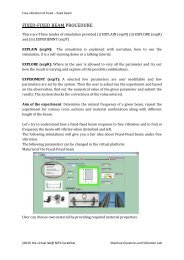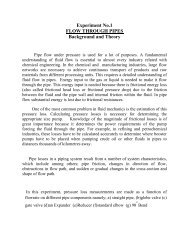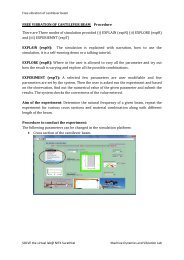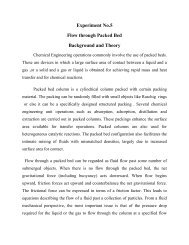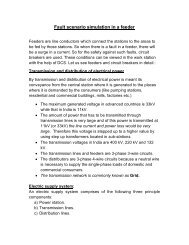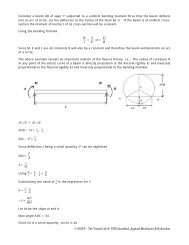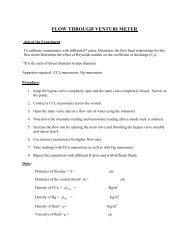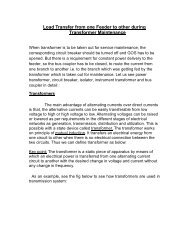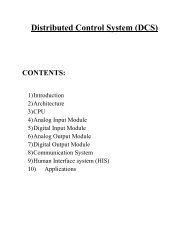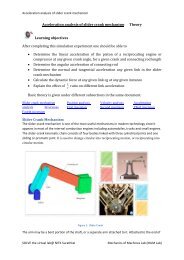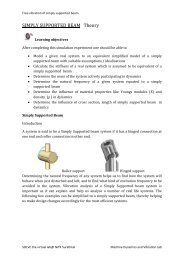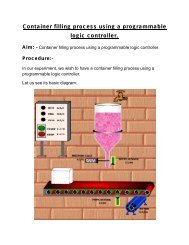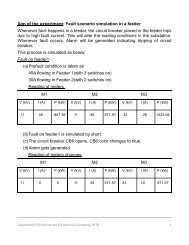Experiment No.4: Flow through Venturi meter Background and ...
Experiment No.4: Flow through Venturi meter Background and ...
Experiment No.4: Flow through Venturi meter Background and ...
You also want an ePaper? Increase the reach of your titles
YUMPU automatically turns print PDFs into web optimized ePapers that Google loves.
<strong>Experiment</strong> <strong>No.4</strong>: <strong>Flow</strong> <strong>through</strong> <strong>Venturi</strong> <strong>meter</strong><strong>Background</strong> <strong>and</strong> TheoryIntroduction<strong>Flow</strong> <strong>meter</strong>s are used in the industry to measure the volumetric flow rate of fluids.Differential pressure type flow <strong>meter</strong>s ( Head flow <strong>meter</strong>s)measure flow rate byintroducing a constriction in the flow. The pressure difference caused by theconstriction is correlated to the flow rate using Bernoulli's theorem.If a constriction is placed in a pipe carrying a stream of fuid,there will be anincrease in velocity,<strong>and</strong> hence an increase in kinetic energy ,at the point ofconstriction.From an energy balance as given by Bernoulli’s theorem,there must bea corresponding reduction in pressure.Rate of discharge from the constriction canbe calculated by knowing this pressure reduction,the area available for flow at theconstriction ,the density of the fluid <strong>and</strong> the coefficient of discharge C d . Coefficientof discharge is the ratio of actual flow to the theoretical flow <strong>and</strong> makesallowances for stream contraction <strong>and</strong> frictional effects. <strong>Venturi</strong> <strong>meter</strong>, orifice<strong>meter</strong>, <strong>and</strong> Pitot tube are widely used head flow <strong>meter</strong>s in the industry. The Pitotstaticis often used for measuring the local velocity in pipes or ducts. Formeasuring flow in enclosed ducts or channels, the <strong>Venturi</strong> <strong>meter</strong> <strong>and</strong> orifice <strong>meter</strong>sare more convenient <strong>and</strong> more frequently used. The <strong>Venturi</strong> is widely usedparticularly for large volume liquid <strong>and</strong> gas flows since it exhibits little pressureloss. However, for smaller pipes orifice <strong>meter</strong> is a suitable choice. In order to useany of these devices for measurement it is necessary to empirically calibrate them.That is, pass a known volume <strong>through</strong> the <strong>meter</strong> <strong>and</strong> note the reading in order toprovide a st<strong>and</strong>ard for measuring other quantities.<strong>Venturi</strong> <strong>meter</strong>:One of the disadvantages of orifice <strong>meter</strong>s is the large irreversible pressure lossacross the orifice, which results in substantial pumping costs in case of largedia<strong>meter</strong> pipes. However, the same principle can be exploited with only minimalpressure loss with the use of a <strong>Venturi</strong> <strong>meter</strong>. In this case, the <strong>meter</strong> consists of asection with both a smooth contraction <strong>and</strong> a smooth expansion. Because of the
smoothness of the contraction <strong>and</strong> expansion, the irreversible pressure loss is low.However, in order to obtain a significant measurable pressure drop, thedownstream pressure tap is placed at the “throat” of the <strong>meter</strong>; i.e., at the point ofthe smallest dia<strong>meter</strong>. <strong>Venturi</strong><strong>meter</strong> is used to measure the rate of flow <strong>through</strong> apipe. <strong>Venturi</strong><strong>meter</strong> consists of a converging portion, throat <strong>and</strong> a diverging portion.The function of the converging portion is to increase the velocity of the fluid <strong>and</strong>temporarily lower its static pressure. The pressure difference between inlet <strong>and</strong>throat is developed. This pressure difference is correlated to the rate of flow. Theexpression for theoretical flow rate is obtained by applying the continuity equation<strong>and</strong> energy equation at inlet <strong>and</strong> throat section.For measuring discharge we should apply Bernoulli’s equation at point 1 <strong>and</strong> at point 2.Thefollowing treatment is limited to incompressible fluids. Friction is neglected , the <strong>meter</strong> isassumed to be horizontal <strong>and</strong> there is no pump. If v1 <strong>and</strong> v2 are the average velocities at point 1<strong>and</strong> point 2 respectively <strong>and</strong> ρ is the density of fluid.(P /ρg) + (v /2g) + z = (P /ρg) + (v /2g) + z1 1 2 1 2 2 2 2Since z 1 =z 2(v /2g) – (v /2g) = (P /ρg) – (P /ρg)2 2 1 2 1 2
(v – v )/2g = (P /ρg) – (P /ρg) ------- (1)2 2 1 2 1 2Now applying the equation of continuity at both points, we haveA v = A v1 1 2 1 ------(2)v = (A x v )/ A --------(3)2 1 1 2v 2 =(d 1 2 x v 1)/ d2 2 --------- (4)where d 1 <strong>and</strong> d 2 are the dia<strong>meter</strong>s at point 1(pipe) <strong>and</strong> at point 2(throat) respectively.Now putting the value of V 2 in the above expression (1) <strong>and</strong> if β= d 2 /d 1 , we have(5)Q = A 2 .v 2 (6)(6)Qth is the theoretical flow rate as computed from Eq.(6) <strong>and</strong> applies to frictionless flow ofincompressible fluids. Actual flow includes frictional loss between point 1 <strong>and</strong> 2.So to accountfor small friction between points 1 <strong>and</strong> 2,Q = C .Q = D th (6)Where C D is called as co-efficient of discharge <strong>and</strong> it depends upon the type of flow, type offluid <strong>and</strong> dimensions of venture tube <strong>and</strong> pipe.
(6)It is the ratio of actual flow rate to the theoretical flow rate.For a well designed venture the constant C D is about 0.98 for pipe dia<strong>meter</strong>s of 2 to 8inches <strong>and</strong>about 0.99 fro larger sizes.The equation relating flow rate to pressure drop isWhere C D is the coefficient of discharge for venturi<strong>meter</strong>. A t is the crosssectionalarea of the throat <strong>and</strong> β is the ratio of throat dia<strong>meter</strong> to pipe dia<strong>meter</strong>.For a <strong>Venturi</strong>, C d = 0.99 for 10 5 < N Re < 10 7 is a useful approximationThe pressure recovery is much better for the venturi <strong>meter</strong> than for the orificeplate.The main advantages of the <strong>Venturi</strong> over the orifice plate are• low head loss.Around 90% of the pressure is recovered.• less affected by upstream flow disturbance• good performance at higher β• even more robust•The venturi tube is suitable for clean, dirty <strong>and</strong> viscous liquid <strong>and</strong> some slurryservices• self-cleaning• less affected by erosionThe disadvantages compared to the orifice are• occupies longer length of pipe• more expensive (manufacture <strong>and</strong> installation)
N ReDischarge Coefficients against Reynold’s Number(D t <strong>and</strong> V t are the thoat dia<strong>meter</strong> <strong>and</strong> velocity at the throat respectevily.



